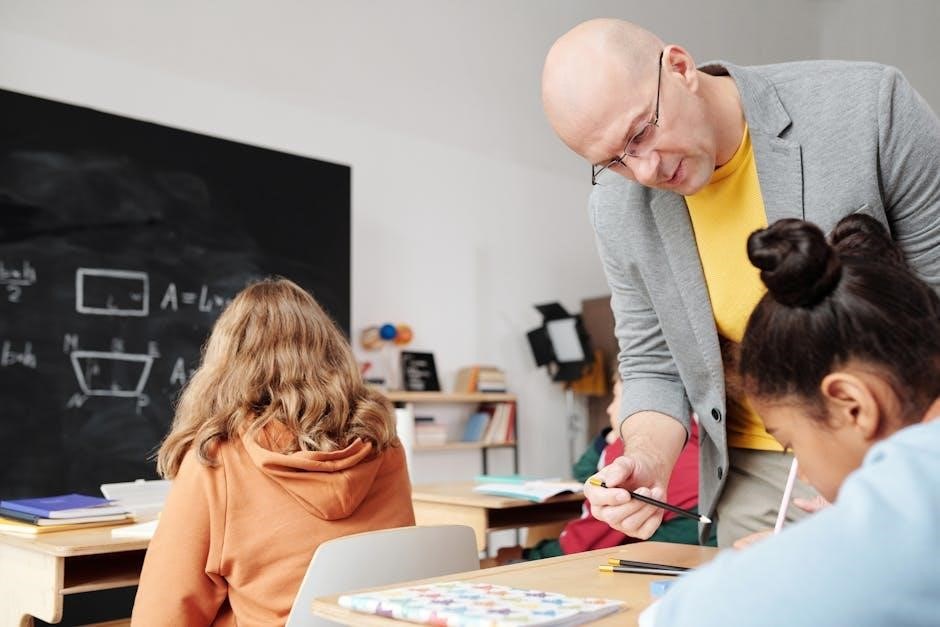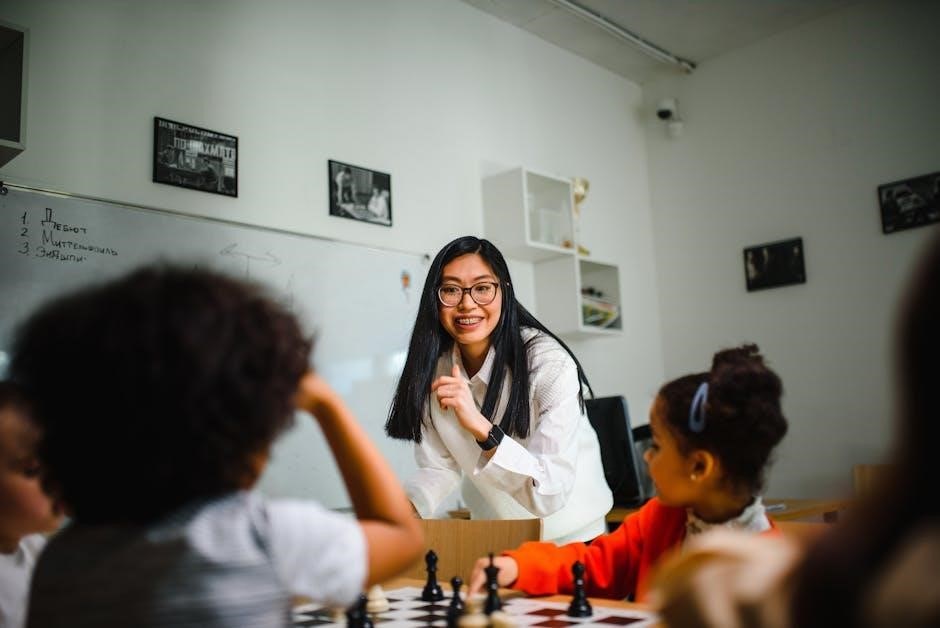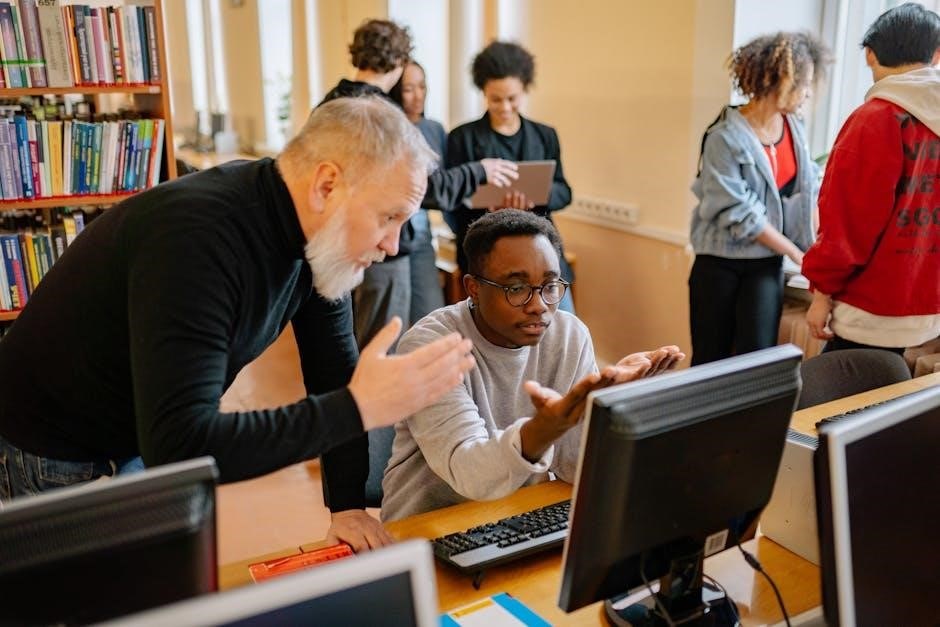The Inclusive Classroom Strategies provide effective methods for teachers to support diverse students with unique needs and abilities in general education classrooms settings.
Definition of Inclusive Classroom! Inclusive classrooms are learning environments that welcome and support students with diverse backgrounds, abilities, and learning needs
Inclusive classrooms are defined as learning environments that value diversity and provide support to students with varied backgrounds, abilities, and learning needs; These classrooms foster a sense of belonging and promote social and academic growth. By acknowledging and respecting individual differences, inclusive classrooms create a positive and engaging atmosphere, allowing students to thrive and reach their full potential. This approach recognizes the importance of diversity and promotes equal opportunities for all students to succeed, regardless of their abilities or backgrounds, in a supportive and inclusive learning environment.

Characteristics of Diverse Student Population
Students are diverse culturally and economically with varying academic readiness and learning profiles always requiring unique support systems and methods.
Students in the 21st-century classroom are diverse culturally, economically, and linguistically, with disparate needs and abilities, requiring teachers to differentiate instruction to meet their unique needs
Students in the 21st-century classroom have varying academic readiness, interest levels, and individual learning profiles, and some may have severe learning and behavioral challenges, requiring teachers to adapt their instruction to meet the diverse needs of their students, using strategies that address students’ strengths, interests, skills, and readiness for learning, in a flexible classroom environment that promotes inclusion and supports the diverse needs of all students, with the goal of providing an equitable education for all, regardless of their background or abilities, and helping them to succeed in their academic pursuits.
Importance of Differentiated Instruction
Differentiated instruction is crucial for meeting diverse students’ needs and abilities in flexible classroom environments daily always.
Teachers need to differentiate instruction, using strategies that address students’ strengths, interests, skills, and readiness for learning, in a flexible classroom environment to ensure all students receive an equitable education
Teachers must use strategies that cater to students’ individual needs, skills and interests to provide equitable education. This involves creating a flexible classroom environment where students can learn at their own pace. The Inclusive Classroom Strategies provide teachers with practical methods to differentiate instruction, ensuring all students receive a high-quality education. By using these strategies, teachers can promote academic success, improve student motivation and create a supportive learning environment that values diversity and inclusivity, ultimately leading to better student outcomes and a more positive learning experience for all students in the classroom.
Effective Inclusive Teaching Practices
Teachers use flexible instructional methods to engage students and promote academic success in inclusive classroom environments every day naturally.
The Inclusive Classroom presents inclusion strategies within the overall framework of effective instruction in general education classrooms, clearly explaining the fundamentals of inclusive teaching and ways to differentiate instruction for specific learners
The Inclusive Classroom provides a comprehensive approach to teaching, focusing on creating a supportive learning environment that caters to the diverse needs of students. This approach emphasizes the importance of understanding individual learning styles, abilities, and interests, and offers practical strategies for differentiating instruction to meet the unique needs of each learner. By implementing these strategies, teachers can promote academic success, social growth, and emotional well-being for all students, regardless of their background or ability, and create a truly inclusive classroom environment that values diversity and promotes equity. Effective instruction is key to student success.

Key Components of Inclusive Classroom Strategies
Inclusion checklists and references are essential components for teachers to create inclusive learning environments effectively always.
Promoting transitions, inclusion checklists, and references are essential components of inclusive classroom strategies, providing teachers with the tools and resources needed to create an inclusive learning environment
Teachers can use inclusion checklists to assess their classroom environment and identify areas for improvement, ensuring all students receive equal opportunities. References provide additional guidance on implementing inclusive strategies, promoting transitions and supporting students with diverse needs. By utilizing these components, teachers can create a welcoming and supportive learning environment, fostering academic success and social growth for all students, regardless of their abilities or backgrounds, and helping them to reach their full potential in a flexible and inclusive classroom setting always.

Book Resources for Inclusive Classroom Strategies
Amazon offers The Inclusive Classroom book with free shipping on qualifying orders always online.
The Inclusive Classroom: Strategies for Effective Differentiated Instruction by Margo A. Mastropieri and Thomas E. Scruggs is a valuable resource for teachers, providing practical strategies and techniques for creating an inclusive classroom environment
The book by Margo A. Mastropieri and Thomas E. Scruggs offers a comprehensive guide to inclusive classroom strategies, providing teachers with practical methods to support students with diverse needs and abilities, and is available on Amazon with free shipping on qualifying orders, making it a valuable resource for educators seeking to create an inclusive learning environment, with effective differentiated instruction techniques and strategies for promoting student success and engagement in the classroom setting every day.
Organizing Inclusive Classroom Strategies
Inclusive classroom strategies are organized into editions providing comprehensive overviews of methods for effective teaching and learning environments always successfully.
The book is organized into seven editions, with each edition providing a comprehensive overview of inclusive classroom strategies, including the fundamentals of inclusive teaching, effective differentiated instruction, and promoting inclusion with classroom peers
The seven editions of the book provide a thorough examination of inclusive classroom strategies, with each edition building on the previous one to create a comprehensive understanding of effective teaching methods. The book’s organization allows teachers to easily access and implement the strategies in their own classrooms, promoting a more inclusive learning environment for all students. The editions cover a range of topics, from the fundamentals of inclusive teaching to promoting inclusion with classroom peers, making it a valuable resource for educators. The book’s structure is easy to follow and understand, with clear explanations and examples.

Part I: The Fundamentals of Inclusive Classroom Strategies
Part I covers foundational concepts and principles of inclusive classroom strategies effectively.
Part I of the book covers the fundamentals of inclusive classroom strategies, including effective differentiated instruction for all students, response to intervention, and multi-tiered systems of support, providing teachers with a solid foundation for creating an inclusive learning environment
Part I of the book provides a comprehensive overview of the fundamentals of inclusive classroom strategies, including effective differentiated instruction, response to intervention, and multi-tiered systems of support. This section is designed to provide teachers with a solid foundation for creating an inclusive learning environment, where all students can thrive and reach their full potential. The book covers topics such as academic readiness, interest level, and individual learning profiles, and provides practical strategies for supporting students with diverse needs and abilities, making it a valuable resource for educators. The information is presented in a clear and concise manner.
